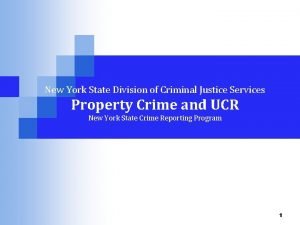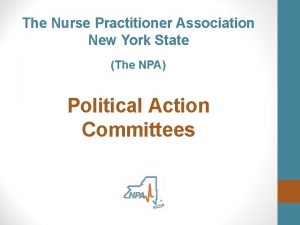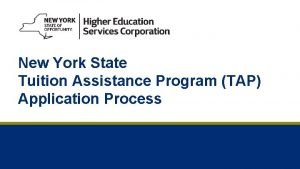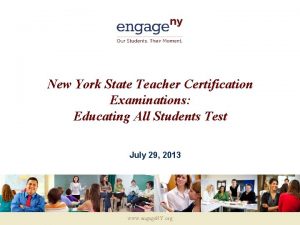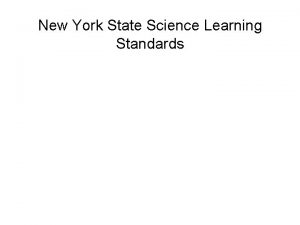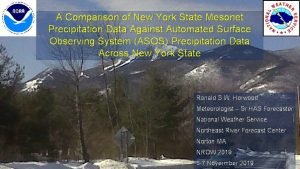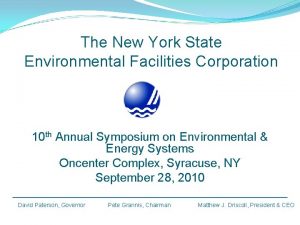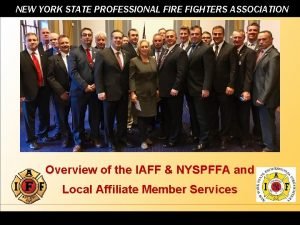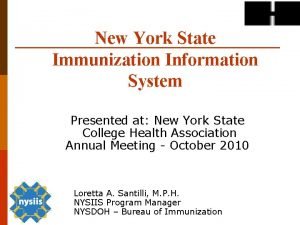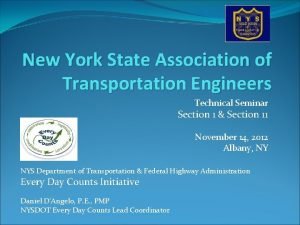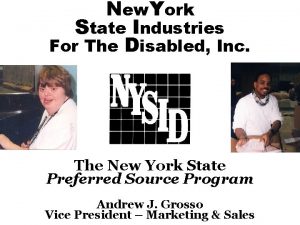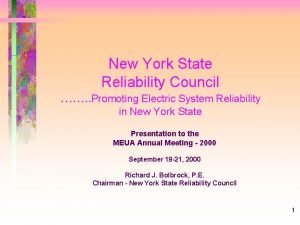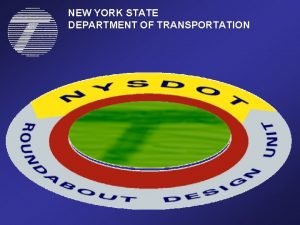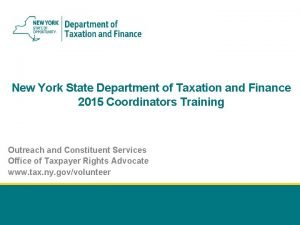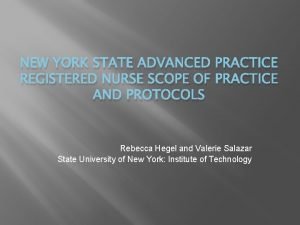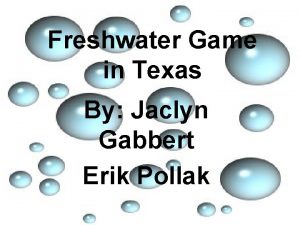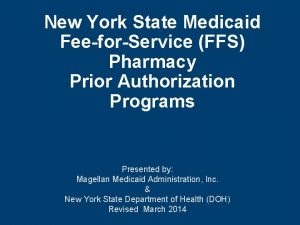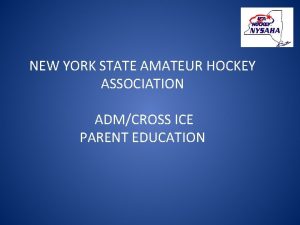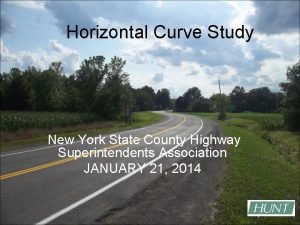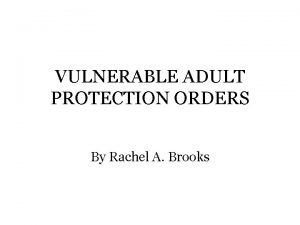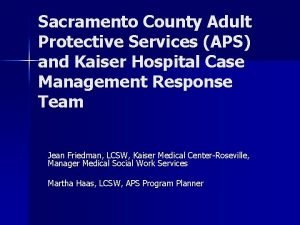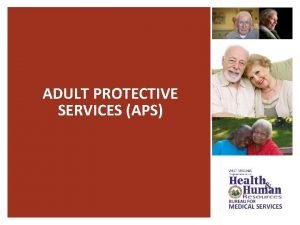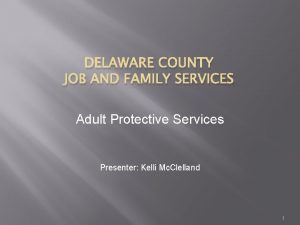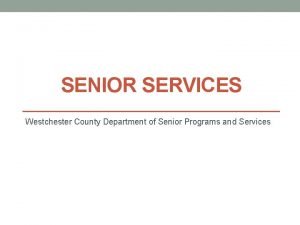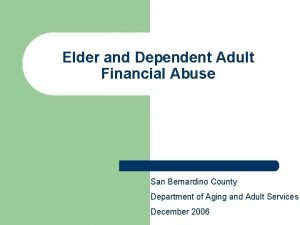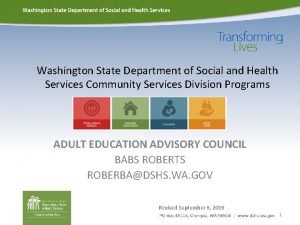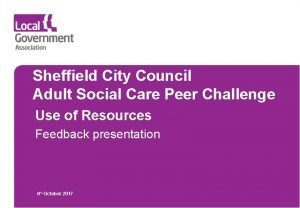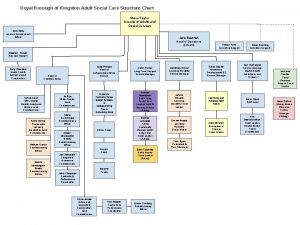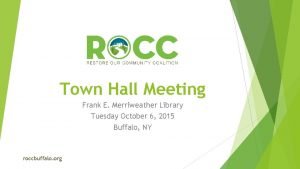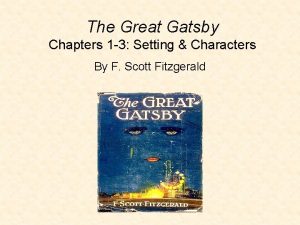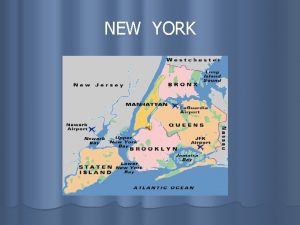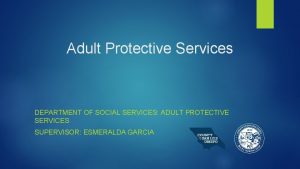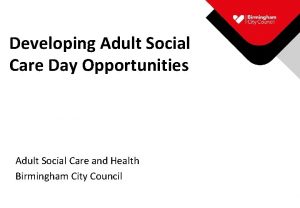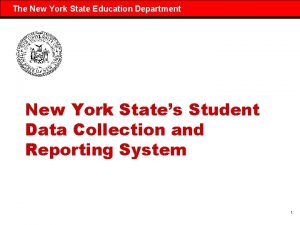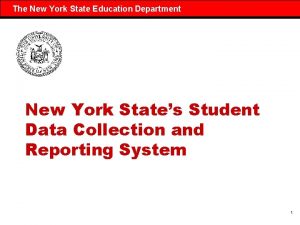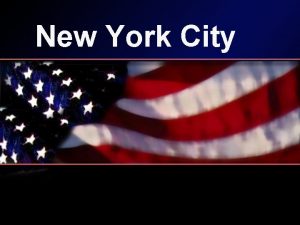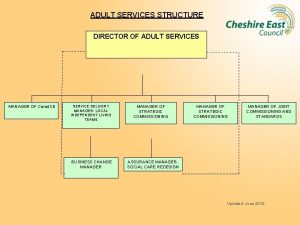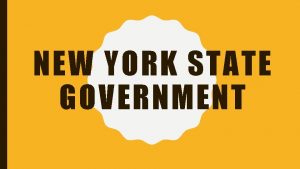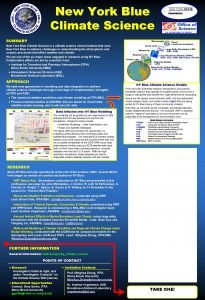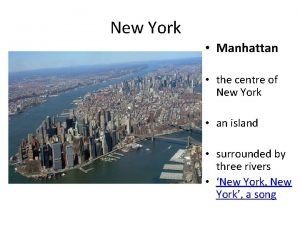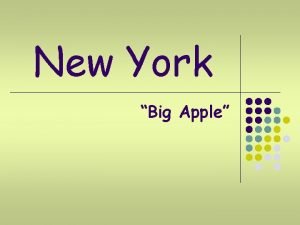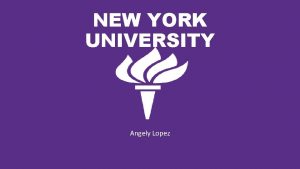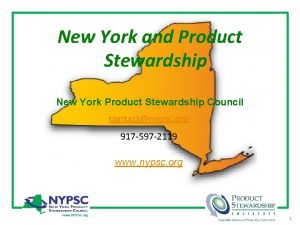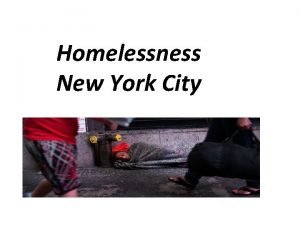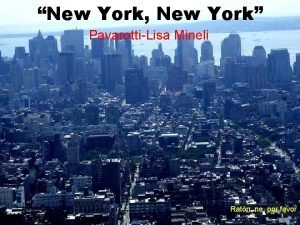Social Adult Day Services 2017 New York State








































- Slides: 40

Social Adult Day Services – 2017 New York State Adult Day Services Association – 2017 Annual Conference

November 30, 2020 2 NYSOFA Mission • The mission of the New York State Office for the Aging is to help older New Yorkers to be as independent as possible for as long as possible through advocacy, the development and delivery of personcentered, consumer-oriented, and cost-effective policies, programs and services which support and empower older New Yorkers and their families, in partnership with the network of public and private organizations which serve • NYSOFA is an Executive Agency, authorized under the federal Older Americans Act and NYS Elder Law

November 30, 2020 The Older Americans Act “Countervailing Force” to Medicare and Medicaid • Passed in 1965 • The primary federal discretionary funding source for home and community based services for older adults • The goal: keep older adults healthy and independent, and living in the community. • Established the Aging Services Network • Focused on multi-disciplinary partnerships at community level • Evolution over time 3

November 30, 2020 4 The Message

November 30, 2020 Services Provided by the Aging Network • • • Case management Home delivered meals (HDM) Congregate meals Nutrition counseling & education NY Connects (ADRC) - LTSS I&A/R, options counseling, benefits and application assistance Health Insurance Information , Counseling and Assistance (HIICAP) Personal Care Level I and II (non-Medicaid) Senior center programming Health promotion and wellness Evidence Based Interventions – CDSMEs, fall prevention, etc Volunteer opportunities Caregiver support services for those caring older adults, older adults caring for adult children with disabilities, grandparents raising grandchildren 5

November 30, 2020 Services Provided by the Aging Network • Respite • • • Support groups Public education and outreach Ancillary services such as PERS and assistive devices • Social adult day services • • Transportation to needed medical appointments, community services and activities Employment – Title V Legal Services Home modifications, repairs Bill paying Long Term Care Ombudsman Increasingly, disaster preparedness & assistance 6

November 30, 2020 Services Provided by the Aging Network • • Local network of service and support providers: 59 AAAs – network of over 1, 200 community providers and growing • • Medicaid Currently serving over 13, 000 duals – 7, 200 with diagnosed behavioral health issue Most clients have 2+ ADL and 3+ IADL limitations • Aging in place through cost effective community-based services • Innovators • Partnerships • Evolving 7

November 30, 2020 8 New York State SADS History • In 1979, the Community Services for the Elderly Program, CSE, was established to better develop community service delivery systems. • In 1981 -82, NYSOFA funded 8 adult day care projects with $269, 000 of CSE funds for innovative specialized services.

November 30, 2020 9 New York State SADS History • NYSOFA continues to fund SADS with Older American Act, CSE and Grant-in-Aid funds. In 1986, EISEP is established and will allow funds for SADS under non-institutional respite. • In 1987, “The Role of Adult Day Care in New York State’s Long Term Care Continuum” is released by the NYS Long Term Care Coordinating Council and recognizes NYSADSA’s consultation contributions.

November 30, 2020 10 New York State SADS History • In 1988, the National Council on Aging (NCOA) establishes SADS standards. • In 1992, NYSOFA conducts statewide survey of SADS and estimates that approximately 100 programs are in NYS. • March 2, 1994, NYS Regulation for Social Adult Day Care adopted for programs funded by NYSOFA and AAAs.

November 30, 2020 11 New York State SADS History • In 1996, NYSADSA conducts membership survey. One-third of SADS participants and income are private pay. • In 1997, NYSOFA releases report on Social Adult Day Care and does not recommend the establishment of uniform standards for all state agencies. NYSADSA supports regulation by the state agency to ensure quality of service and improve SADS’s position in the long term care continuum.

November 30, 2020 12 New York State SADS History • In 2000, the National Family Caregiver Program allows SADS funding for respite as a caregiver service. • June 2000, NYSOFA releases RFP for SADS with legislative funding of $970, 000. 18 programs are funded. • June 2007, NYSOFA releases RFP for new SADS with legislative funding of $500, 000. 6 programs are funded for two years. • In the 2010 Met Life national survey of ADS, the most frequent reasons for participant discharge was nursing home placement, death and significant health decline.

November 30, 2020 13 New York State SADS History • In fiscal year 2017 -18, NYSOFA provided $1. 1 million in funding for 15 SADS contractors, while • AAAs provided an additional $4. 5 million of direct funding to 77 SADS operating in their counties.

November 30, 2020 14 Medicaid Plan Amendment • In 2011, DOH proposed an amendment to New York’s Medicaid program (Section 1115) that would mandate enrollment in an MLTC for certain Medicaid recipients, including those receiving both Medicare and Medicaid and requiring community-based long-term care for more than 120 days. • On August 31, 2012 the U. S. Department of Health and Human Services approved the amendment, thereby making MLTC enrollment mandatory effective September 2012. DOH is a stakeholder in SADS – both indirectly as overseer of MLTC plans, which deliver program services, and directly as the administrator of the State’s Medicaid program, which is accountable for oversight of Medicaid dollars.

November 30, 2020 15 DOH Funding for SADS According to DOH officials, for the two calendar years 2013 and 2014, SADS providers received over $175 million in Medicaid funding for services delivered through MLTC plans. Over 15, 000 individuals where served in Medicaid funded SADS programs. There are 335 registered SADS in New York City (not DFTA funded but registered with the agency ) Source – OSC 2015 report and DFTA

November 30, 2020 16 Who is being served Nursing Home Risk Factors Adult Day Services Clients** Average Age Below 150% of Poverty* 82. 4 32% 3+ IADL Difficulty 3+ ADL Difficulty High Nutritional Risk 95% 60% 22% Live alone Other Cost of Service 25% ** $12. 13 an hour **Sixty-nine percent of these participants have Alzheimer’s disease or another type of dementia and require hands on assistance with at least 2 to 3 activities of daily living

November 30, 2020 17 More Data 2016 -2017 Data: A total of 1, 138 participants received services through the NYSOFA funded programs. Highlights of participant’s characteristics include: Ø Ø Ø Age 75 to 85: 35% Age 85+: 28% Alzheimer’s disease/other dementia: 67% Require continual supervision: 55% Hands on assistance for toileting: 33% Hands on assistance for mobility and transfers: 32%

November 30, 2020 Assistance for Caregivers 2016 -2017 Data: A total of 1, 099 caregivers received services through the NYSOFA funded programs. Highlights of caregiver’s situations include: Ø Live with participant: 72% Ø Work: 51% Ø Son or daughter: 47% Ø Spouse: 34% 18

November 30, 2020 19 Discharge Data 2016 -2017 Data: • A total of 338 participants were discharged from the NYSOFA funded programs. In general, for participants that enroll in a program, 7 of 10 participants will continue for six months or longer, with an average length of stay of three and one-half years. Discharged data highlights include: Ø Remained in program until facility placement or death: 38% Ø Remained in program for six months or longer: 68% Ø Average length of stay: 41 months

November 30, 2020 20 Demographic Change • Race and Ethnic Diversity Growth in all categories • • • Migration Young workforce New retirees Frail older adults Young people Minorities -- -- --- out of state back to NY out of rural areas into suburban and rural areas

November 30, 2020 21 Demographic Change

November 30, 2020 NYSOFA’s Priorities Include • Strengthening core OAA and state funded services to meet existing and future needs among older adults and their families; • Expanding and strengthening the states No Wrong Door to serve all populations, regardless of age or payer source; • Increasing the business acumen of the network to strengthen partnerships with health care providers and to develop models that reach new populations; • • Working with other state agencies and local partners to prevent readmission to hospitals; Teaching older adults how to manage complex chronic conditions and working to expand to other populations; 22

November 30, 2020 23 NYSOFA’s Priorities Include • Providing one-on-one assistance to understand the complexities of and navigating Medicare and other health insurance; • Assisting individuals in understanding, applying for and receiving benefits they may be eligible for; • Supporting caregivers of all ages to continue to serve their loved ones; • Marketing the value of network services in health care and LTSS reorganization; and • Instituting measurements and metrics to determine the efficacy of programs and for program/service improvements. • Demonstrating the economic, social and intellectual capital older adults bring to their communities

November 30, 2020 24 Retain retirees and older adults in our communities Ø $50 billion a year is paid to New Yorkers through Social Security, 65% of this is received by our older residents and they receive billions in retirement pension benefits, a majority of which are used to purchase goods and services. Ø In New York according to the U. S. Census Bureau - 72 percent of persons over 60 own their own homes - pay real property taxes and do not create additional demands on a community’s local school system. Ø Over 700, 000 older adults volunteer over 119 million hours at an economic value of $3. 35 billion annually. Ø 80%-90% of long-term care is provided by over 4. 1 million informal caregivers in New York – average of a caregiver, 64. If paid for at market rate - $32 billion 24

November 30, 2020 25 New York State Highlights • 3. 7 million people 60+ - rank #3 nationally • Very diverse group – physically, culturally, ethnically, economically, educationally, health status, etc. • 5. 5 million between the ages of 45 -59 • 1. 8 million people age 75+ - fastest growing cohort in NYS

November 30, 2020 Ages 26 Aggregate Personal Income by Age - NYS Less than 24 25 to 44 45 to 64 65 and over TOTAL • Aggregate Personal Income % of Total $ 8, 934. 627. 400 $216, 111, 979, 400 $282, 022, 363, 700 $ 97, 278, 275, 500 1. 48% 35. 76% 46. 67% 16. 10% $604, 347, 246, 000 In addition to the billions in income generated from this age group, according to the AARP, persons over the age of 50 control half of the country's discretionary spending, over $7 trillion.

November 30, 2020 27 Understanding of Aging – What do We Really Want? • • • To make our own decisions and to be a part of decisions made about us To be as independent as possible To have choices To be able to assume personal risk, be in control To stay in their homes/communities To maintain relationships, have purpose To access and receive assistance as needed, on our terms and schedules Not be vilified for asking for help Help maneuvering various systems that are complex – i. e health care, application assistance, rules and regulations

November 30, 2020 28 Economic Development: Ø Gray Gold - States court retirees as a "clean" growth industry. (Source: Federal Reserve of Minneapolis and National Conference of State Legislators) Ø The "graying" of the U. S. population creates substantial opportunities for businesses that target their products and services at older consumers. Increasingly, economic development experts - regard affluent, mobile retirees as a key customer base with a stable stream of income to be spent on local purchases and investments. (Source: Federal Reserve of Minneapolis and National Conference of State Legislators)

November 30, 2020 29 Older Adults Opening New Business: Ø An aging population has led to a rising share of new business owners in the age 55 to 64 cohort. Ø This group represented 14. 8% of new business owners in 1996, whereas it represented 25. 8%in 2015 (source: Kaufman Foundation – State Index)

November 30, 2020 30 Social Factors Directly Impact Health Spending Ø Health policy has focused on paying for interventions that address medical needs, not social needs. Ø Payers had little incentive to cover social interventions that provide long term clinical and financial rewards. Payments based on procedures/tests, visits and discharges – not clinical outcomes. Ø Income, access to food, educational status, housing, employment affect health and longevity. v Research attributes as much as 40% of health outcomes to social and economic factors (University of Wisconsin Population Health Institute) ü Food insecurity and diabetes related admissions ü Living conditions and asthma ü Physical activity and obesity

November 30, 2020 31 Health Needs Older adults Ø 80% have at least one chronic condition Ø 50% have at least 2 Means more visits to health professionals, more medications, decline in overall wellbeing and quality of life. Means limited mobility, social isolation and need for LTSS more common. Health care cannot solve the problem. Need Communities to plan for and accommodate, map assets and opportunities and design a new paradigm.

November 30, 2020 32 Costs Associated with Chronic Conditions q Cost of an individuals independence and quality of life q Costs for long-term care – exceed $500 billion nationally Out of pocket costs for individuals - ü Co-pays, premiums, deductibles ü Prescriptions, then run risk of adverse interactions ü Spend-down q Business costs – loss productivity and health spending

November 30, 2020 33 Changes Are Occurring - Federal and State Direction – Rebalance LTSS • Olmstead Plan • • • Medicaid Redesign Team (MRT) Health Homes Fully Integrated Dual Advantage (FIDA) Managed Long Term Care (MLTC) Balanced Incentive Program (BIP) Community First Choice Option (CFCO) Money Follows the Person (MFP) Center for Medicare and Medicaid Innovation (CMMI) Delivery System Reform Incentive Payment Program (DSRIP) Accountable Care Organizations, etc.

November 30, 2020 34 Governor Cuomo - 2017 Health Across All Policies Approach ØA collaborative approach to improving health and wellness by incorporating health considerations into decision making across sectors and policy areas. ØIt includes seeking designation from the World Health Organization of New York as the First Age Friendly State. (Source: 2017 – State of the Address-New York State Excelsior/ Ever Upward)

November 30, 2020 35 Age Friendly Communities = Healthy Communities Ø Makes healthy lifestyle choices easy and accessible for all community members. Ø Age Friendly community design links the traditional concepts of planning (such as land use, transportation, community facilities, parks, and open space) with health themes (such as physical activity, public safety, healthy food access, mental health, air and water quality, and social equity issues).

November 30, 2020 36 Why Age Friendly/Livable Communities?

November 30, 2020 37 Bicycling: • Half of all trips taken in the United States are three miles or less, yet most Americans drive. Only 3 percent of commuting trips in the U. S. are by bicycle, • Building bike infrastructure creates an average of 11. 4 jobs for every $1 million spent. Road-only projects create 7. 8 jobs per $1 million. Density: • The Federal Reserve Bank of New York found that a doubling of an area’s density increases worker productivity by up to 4 percent. When the housing market imploded in the late 2000 s, the neighborhoods that held their property values the best were high density communities that featured a mix of uses (housing, retail, restaurants and office space) located within a walkable core. Economic Development: • For many years, public transit, bicycle lanes, trails and sidewalks have suffered from a lack of investment resulting in congestion, inactivity and obesity, as well as more air pollution and traffic crashes and a loss of economic vitality. • Houses with above-average levels of walkability command a premium of about $4, 000 to $34, 000 more than homes with average levels of walkability. A 1999 study by the Urban Land Institute of four new walkable communities determined that home buyers were willing to pay $20, 000 more for the houses than they would for similar homes in less walkable areas.

November 30, 2020 38 Form- Based Code: • Traditional zoning rules often promote low-density development and limited “one-size fits-all” housing choices encouraging excessive land consumption and automobile dependency. Such zoning can stand in the way of communities seeking to create vibrant, walkable neighborhoods that give residents the option of walking to a store, park or work. Sidewalks: • Eight in 10 Americans prefer being in a community that offers sidewalks and good places to walk. Six in 10 prefer a neighborhood that features a mix of houses, shops and services within an easy walk versus a neighborhood that requires a car for every errand. • *People who live in neighborhoods with sidewalks are 47 percent more likely than residents of areas without sidewalks to be active at least 39 minutes a day. Trees: • The National Main Street Center reports that a good tree canopy can increase retail sales by 12 cents on the dollar in large cities and 9 cents on the dollar in small ones. • Trees are also good for our health. Vehicle exhaust increases ozone and causes asthma and other medical problems. A single urban street tree converts enough carbon monoxide and carbon dioxide into oxygen to meet the oxygen needs of two people for a full year.

November 30, 2020 NYS – Building on A Foundation • Project 2015 – NYSOFA and all Executive Agencies • Community Empowerment Grants/Conferences • Locally Borne Projects/Planning • Long Island Livability Summit/Conference • Downtown Revitalization Program – Livability Elements • Model Zoning Laws • DOS – Smart growth, Sustainable Planning Conferences 39

November 30, 2020 40 The End
 Department of criminal justice services ny
Department of criminal justice services ny Day 1 day 2 day 3 day 4
Day 1 day 2 day 3 day 4 Nurse practitioner association of new york state
Nurse practitioner association of new york state New york tap application
New york tap application New york state teacher certification examinations
New york state teacher certification examinations New york state learning standards science
New york state learning standards science State test 2018
State test 2018 New york mesonet
New york mesonet Ny state vegetable
Ny state vegetable Gigp-28
Gigp-28 New york state professional firefighters association
New york state professional firefighters association New york state immunization information system (nysiis)
New york state immunization information system (nysiis) New york state association of transportation engineers
New york state association of transportation engineers New york state industries
New york state industries New york state reliability council
New york state reliability council How many roundabouts in new york
How many roundabouts in new york New york state tax practitioner hotline
New york state tax practitioner hotline Nysbon
Nysbon New york state fish
New york state fish New york state nickname
New york state nickname Emedny formulary
Emedny formulary New york state amateur hockey association
New york state amateur hockey association New york state county highway superintendents association
New york state county highway superintendents association New york pennsylvania new jersey delaware
New york pennsylvania new jersey delaware New hartford cinema
New hartford cinema Strengths of articles of confederation
Strengths of articles of confederation Leanne keene french ambassador arrives from paris
Leanne keene french ambassador arrives from paris Day 1 day 2 day 817
Day 1 day 2 day 817 Adult protective services vancouver wa
Adult protective services vancouver wa Adult protective services sacramento
Adult protective services sacramento Adult protective services west virginia
Adult protective services west virginia Adult protective services delaware
Adult protective services delaware Westchester senior services
Westchester senior services Aps san bernardino county
Aps san bernardino county Washington state department of social and health services
Washington state department of social and health services Adult social care sheffield
Adult social care sheffield Adult social care kingston
Adult social care kingston Business etiquette in new york
Business etiquette in new york Procedural vs substantive due process
Procedural vs substantive due process Merriweather library buffalo new york
Merriweather library buffalo new york West egg and east egg in real life
West egg and east egg in real life
